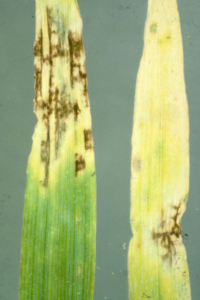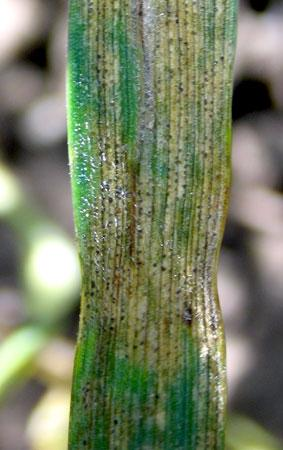Crop health update – Fungicide resistance marches on
7 January 2019Resistance to some of our key fungicides has been of concern for a few years. Monitoring data from 2018, presented at the recent Fungicide Resistance Action Group UK meeting shows that the position for Septoria in wheat has continued to worsen and there were also new and unwelcome developments on the barley front. Luckily field control is 2018 was broadly acceptable, but that had more to do with the heat which helped to dry up any early disease.
Septoria management has been getting harder with azole chemistry declining in efficacy. Data from 2018 suggests that there has been a further creep in efficacy – in 2016 there was some hope that the drift in efficacy had stabilised but the 2017 and 2018 data confirms that the Septoria population is still adapting. The azoles have been ‘propped up’ by the use of SDHI fungicides but the unwelcome surprise in the 2018 monitoring data is the jump in the frequency of mutations which can affect SDHI efficacy in the Septoria population. We’ve seen emerging issues for the last couple of seasons but still at very low levels in the population but it appears as if up to 40% of the populations is now affected with at least one mutation. The better news is that is that many of these mutations have a very low or negligible affect of on efficacy – but there is no denying it is an unwelcome development.

Mutations in net blotch which affect the efficacy of SDHI fungicides increased in 2018
There are several mechanisms that allow fungal pathogens to develop resistance. One is mutations that affect the shape of the target site where the fungicide locks into the fungus. Another mechanism is that the pathogen develops a mechanism to pump toxins fungicides and other toxins to it more rapidly out of its cells. AHDB project data, incorporating SRUC trial sites, shows that Scottish sites tend to have more of that latter type of mutation compared to English sites. It can affect more than one type of fungicide, but fortunately tends to incur large fitness costs for the fungus so target site mutations are still the principle worry.
2018 field trial data demonstrates that the Septoria population can shift very rapidly – after just a single spray of an SDHI or azole the population shifted just slightly to the less sensitive end of the spectrum. Stewardship is vital because that shift was reduced where products were used in mixture (as is the case in real life) and not seen where chlorothalonil was used in the mixture. It remains more important than ever that actives are mixed and alternated where possible and it is crucial that mutisites are used.
Net blotch is another example of a pathogen where SDHI mutations have crept in over recent seasons and the frequency crept up again in 2018. Seventy five percent of the net blotch population now carries some form of mutation which could affect SDHI efficacy – France and Germany seem to be the countries most affected with the UK not far behind. Net blotch is less of a target for Scottish barley fungicides and historically we have done much to manage the disease through certified seed schemes and saving seed of high health status. Fungicide performance data from 2018 also confirms that the efficacy of the strobilurins to net blotch is slightly compromised by the presence of partial resistance in a portion of the populations ( probably around 30%) but in mixtures and programmes control is still broadly acceptable. Ramularia remains a major concern as we are left with only chlorothalonil as an effective option because of widespread resistance to azoles, strobilurins and SDHIs.
Fiona Burnett, SRUC for the Farm Advisory Service
Sign up to the FAS newsletter
Receive updates on news, events and publications from Scotland’s Farm Advisory Service

